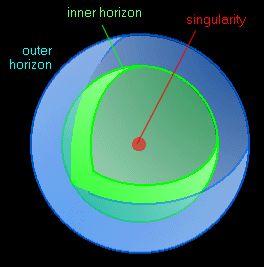Reissner-Nordstrom black hole

Main features of a Reissner-Nordstrom black hole. Credit: N. Rumiano.
A Reissner-Nordstrom black hole is a black hole that is electrically charged but non-rotating. A Reissner-Nordstrom black hole has two separate event horizons; the more charge the black hole carries, the closer are its event horizons. A photon sphere is also always present.
A consequence of the two event horizons is that, upon crossing both of them, space and time exchange roles twice: within the sphere enclosed by the inner horizon (sometimes called the Cauchy horizon, space and time revert to their usual roles. Consequently, it is possible to avoid the singularity, which is of a temporal nature.
If the charge of the black hole is high enough, the two horizons disappear and the singularity becomes a naked one. Many physicists believe that such a situation can't arise: there is a principle of "cosmic censorship," they believe, which prevents naked singularities from ever forming.
Although Reissner-Nordstrom black holes are studied in theory, it is unlikely they would ever come about in practice. Black holes in the real universe almost certainly have some rotation and no overall charge. This means that Kerr black holes are more interesting from a practical perspective.


